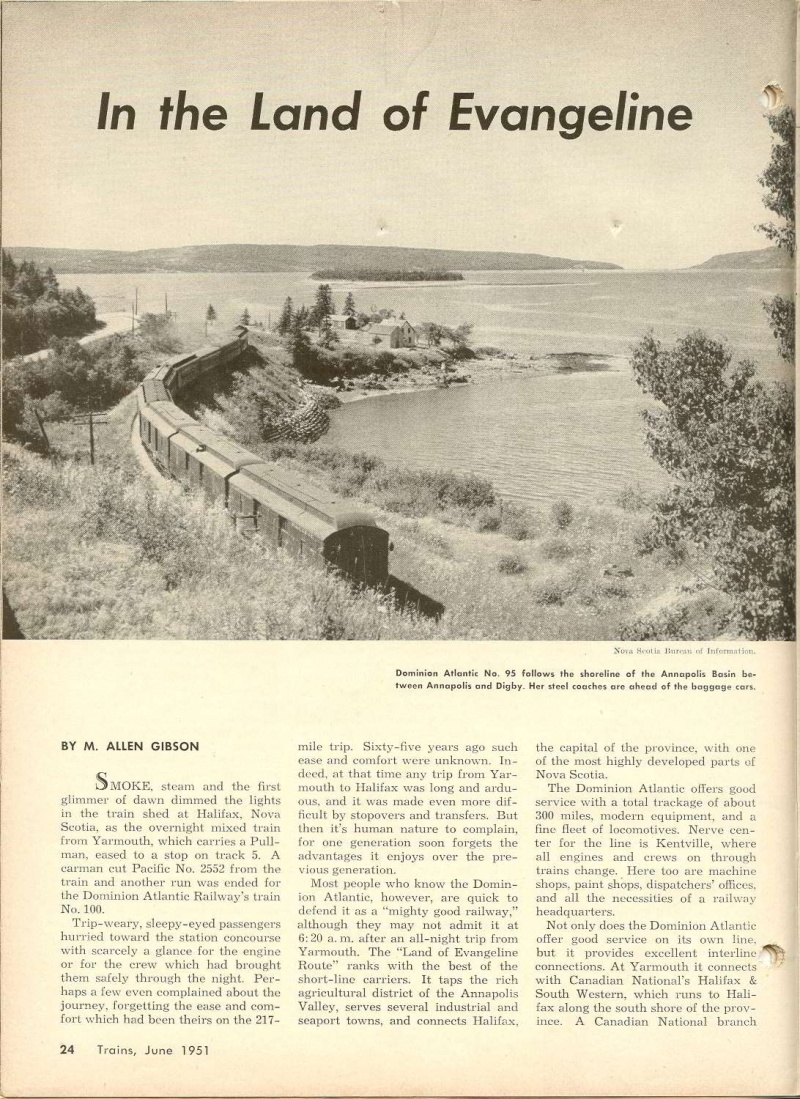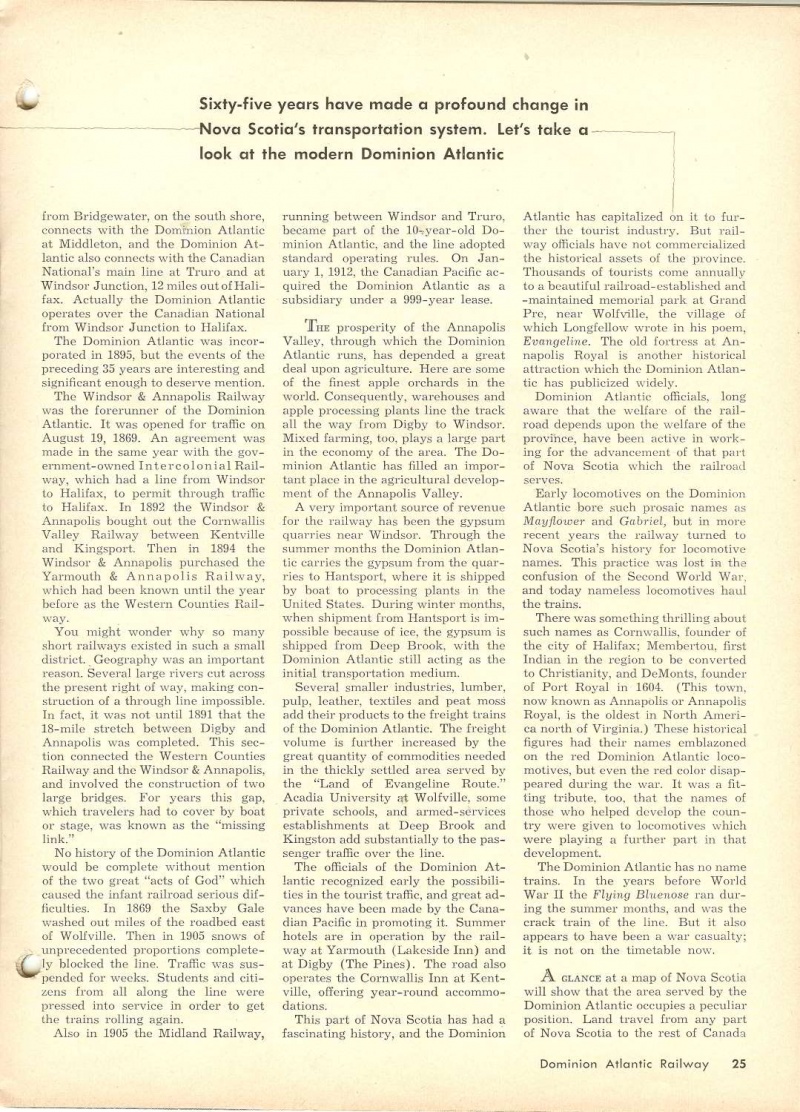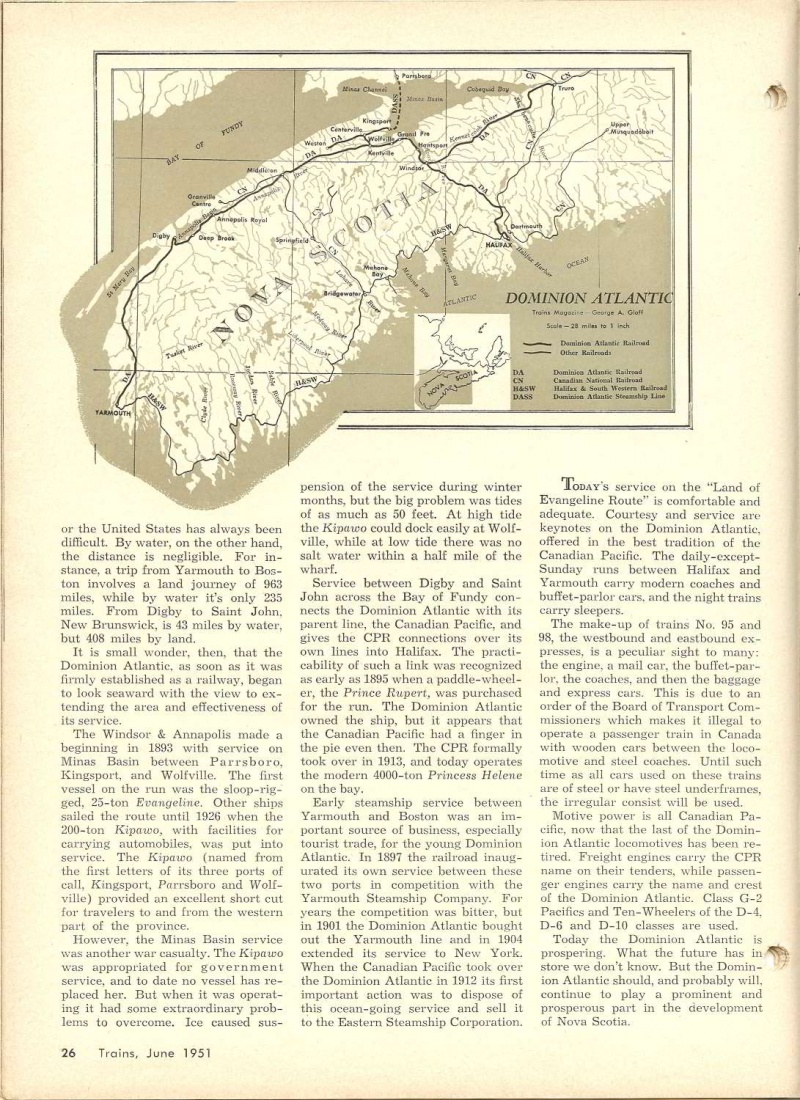Dominion Atlantic Railway Digital Preservation Initiative - Wiki
Use of this site is subject to our Terms & Conditions.
Trains June 1951, In The Land Of Evangeline
Trains June 1951, In The Land Of Evangeline
An article by H. Allen Gibson was printed in the June 1951 issue of Trains magazine. A scan of the three page article is shown here, with a transcript of the text (not including picture captions) below for search purposes and for ease of reading.
Smoke, steam and the first glimmer of dawn dimmed the lights in the train shed at Halifax, Nova Scotia, as the overnight mixed train from Yarmouth, which carries a Pullman, eased to a stop on track 5. A carman cut Pacific No. 2552 from the train and another run was ended for the Dominion Atlantic Railway’s train No. 100.
Trip-weary, sleepy-eyed passengers hurried toward the station concourse with scarcely a glance for the engine or for the crew which had brought them safely through the night. Perhaps a few even complained about the journey, forgetting the ease and comfort which had been theirs on the 217 mile trip. Sixty-five years ago such ease and comfort were unknown. Indeed, at that time any trip from Yarmouth to Halifax was long and arduous, and it was made even more difficult by stopovers and transfers. But then it’s human nature to complain, for one generation soon forgets the advantages it enjoys over the previous generation.
Most people who know the Dominion Atlantic, however, are quick to defend it as a “mighty good railway,” although they may not admit it at 6:20 a.m. after an all-night trip from Yarmouth. The “Land of Evangeline Route” ranks with the best of the short-line carriers. It taps the rich agricultural district of the Annapolis Valley, serves several industrial and seaport towns, and connects Halifax, the capital of the province, with one of the most highly developed parts of Nova Scotia.
The Dominion Atlantic offers good service with a total trackage of about 300 miles, modern equipment, and a fine fleet of locomotives. Nerve center for the line is Kentville, where all engines and crews on through trains change. Here too are machine shops, paint shops, dispatchers’ offices, and all the necessities of a railway headquarters.
Not only does the Dominion Atlantic offer good service on its own line, but it provides excellent interline connections. At Yarmouth it connects with Canadian National’s Halifax & South Western, which runs to Halifax along the south shore of the province. A Canadian National branch from Bridgewater, on the south shore, connects with the Dominion Atlantic at Middleton, and the Dominion Atlantic also connects with the Canadian National's main line at Truro and at Windsor Junction, 12 miles out of Halifax. Actually the Dominion Atlantic operates over the Canadian National from Windsor Junction to Halifax.
The Dominion Atlantic was incorporated in 1895, but the events of the preceding 35 years are interesting and significant enough to deserve mention.
The Windsor & Annapolis Railway was the forerunner of the Dominion Atlantic. It was opened for traffic on August 19, 1869, An agreement was made in the same year with the government-owned Intercolonial Railway, which had a line from Windsor to Halifax, to permit through traffic to Halifax. In 1892 the Windsor & Annapolis bought out the Cornwallis Valley Railway between Kentville and Kingsport. Then in 1894 the Windsor & Annapolis purchased the Yarmouth & Annapolis Railway, which had been known until the year before as the Western Counties Railway.
You might wonder why so many short railways existed in such a small district. Geography was an important reason. Several large rivers cut across the present right of way, making construction of a through line impossible. In fact, it was not until 1891 that the 18-mile stretch between Digby and Annapolis was completed. This section connected the Western Counties Railway and the Windsor & Annapolis, and involved the construction of two large bridges. For years this gap, which travelers had to cover by boat or stage, was known as the “missing link.”
No history of the Dominion Atlantic would be complete without mention of the two great “acts of God” which caused the infant railroad serious difficulties. In 1869 the Saxby Gale washed out miles of the roadbed east of Wolfville. Then in 1905 snows of unprecedented proportions completely blocked the line. Traffic was suspended for weeks. Students and citizens from all along the line were pressed into service in order to get the trains rolling again.
Also in 1905 the Midland Railway, running between Windsor and Truro, became part of the 10-year-old Dominion Atlantic, and the line adopted standard operating rules. On January 1, 1912, the Canadian Pacific acquired the Dominion Atlantic as a subsidiary under a 999-year lease.
The prosperity of the Annapolis Valley, through which the Dominion Atlantic runs, has depended a great deal upon agriculture. Here are some of the finest apple orchards in the world. Consequently, warehouses and apple processing plants line the track all the way from Digby to Windsor. Mixed farming, too, plays a large part in the economy of the area. The Dominion Atlantic has filled an important place in the agricultural development of the Annapolis Valley.
A very important source of revenue for the railway has been the gypsum quarries near Windsor. Through the summer months the Dominion Atlantic carries the gypsum from the quarries to Hantsport, where it is shipped by boat to processing plants in the United States. During winter months, when shipment from Hantsport is impossible because of ice, the gypsum is shipped from Deep Brook, with the Dominion Atlantic still acting as the initial transportation medium.
Several smaller industries, lumber, pulp, leather, textiles and peat moss add their products to the freight trains of the Dominion Atlantic. The freight volume is further increased by the great quantity of commodities needed in the thickly settled area served by the “Land of Evangeline Route.” Acadia University at Wolfville, some private schools, and armed-services establishments at Deep Brook and Kingston add substantially to the passenger traffic over the line.
The officials of the Dominion Atlantic recognized early the possibilities in the tourist traffic, and great advances have been made by the Canadian Pacific in promoting it. Summer hotels are in operation by the railway at Yarmouth (Lakeside Inn) and at Digby (The Pines). The road also operates the Cornwallis Inn at Kentville, offering year-round accommodations.
This part of Nova Scotia has had a fascinating history, and the Dominion Atlantic has capitalized on it to further the tourist industry. But railway officials have not commercialized the historical assets of the province. Thousands of tourists come annually to a beautiful railroad-established and -maintained memorial park at Grand Pre, near Wolfville, the village of which Longfellow wrote in his poem, Evangeline. The old fortress at Annapolis Royal is another historical attraction which the Dominion Atlantic has publicized widely.
Dominion Atlantic officials, long aware that the welfare of the railroad depends upon the welfare of the province, have been active in working for the advancement of that part of Nova Scotia which the railroad serves.
Early locomotives on the Dominion Atlantic bore such prosaic names as Mayflower and Gabriel, but in more recent years the railway turned to Nova Scotia’s history for locomotive names. This practice was lost in the confusion of the Second World War, and today nameless locomotives haul the trains.
There was something thrilling about such names as Cornwallis, founder of the city of Halifax; Membertou, first Indian in the region to be converted to Christianity, and DeMonts, founder of Port Royal in 1604. (This town, now known as Annapolis or Annapolis Royal, is the oldest in North America north of Virginia.) These historical figures had their names emblazoned on the red Dominion Atlantic locomotives, but even the red color disappeared during the war. It was a fitting tribute, too, that the names of those who helped develop the country were given to locomotives which were playing a further part in that development.
The Dominion Atlantic has no name trains. In the years before World War II the Flying Bluenose ran during the summer months, and was the crack train of the line. But it also appears to have been a war casualty; it is not on the timetable now.
A glance at a map of Nova Scotia will show that the area served by the Dominion Atlantic occupies a peculiar position, Land travel from any part of Nova Scotia to the rest of Canada or the United States has always been difficult. By water, on the other hand, the distance is negligible. For instance, a trip from Yarmouth to Boston involves a land journey of 963 miles, while by water it’s only 235 miles. From Digby to Saint John, New Brunswick, is 43 miles by water, but 408 miles by land.
It is small wonder, then, that the Dominion Atlantic, as soon as it was firmly established as a railway, began to look seaward with the view to extending the area and effectiveness of its service.
The Windsor & Annapolis made a beginning in 1893 with service on Minas Basin between Parrsboro, Kingsport, and Wolfville. The first vessel on the run was the sloop-rigged, 25-ton Evangeline. Other ships sailed the route until 1926 when the 200-ton Kipawo, with facilities for carrying automobiles, was put into service. The Kipawo (named from the first letters of its three ports of call, Kingsport, Parrsboro and Wolfville) provided an excellent short cut for travelers to and from the western part of the province.
However, the Minas Basin service was another war casualty. The Kipawo was appropriated for government service, and to date no vessel has re~ placed her. But when it was operating it had some extraordinary problems to overcome. Ice caused suspension of the service during winter months, but the big problem was tides of as much as 50 feet. At high tide the Kipawo could dock easily at Wolfville, while at low tide there was no salt water within a half mile of the wharf.
Service between Digby and Saint John across the Bay of Fundy connects the Dominion Atlantic with its parent line, the Canadian Pacific, and gives the CPR connections over its own lines into Halifax. The practicability of such a link was recognized as early as 1895 when a paddle-wheeler, the Prince Rupert, was purchased for the run, The Dominion Atlantic owned the ship, but it appears that the Canadian Pacific had a finger in the pie even then. The CPR formally took over in 1913, and today operates the modern 4000-ton Princess Helene on the bay.
Early steamship service between Yarmouth and Boston was an important source of business, especially tourist trade, for the young Dominion Atlantic. In 1897 the railroad inaugurated its own service between these two ports in competition with the Yarmouth Steamship Company. For years the competition was bitter, but in 1901 the Dominion Atlantic bought out the Yarmouth line and in 1904 extended its service to New York. When the Canadian Pacific took over the Dominion Atlantic in 1912 its first important action was to dispose of this ocean-going service and sell it to the Eastern Steamship Corporation.
Today's service on the "Land of Evangeline Route” is comfortable and adequate. Courtesy and service are keynotes on the Dominion Atlantic, offered in the best tradition of the Canadian Pacific. The daily-except-Sunday runs between Halifax and Yarmouth carry modern coaches and buffet-parlor cars, and the night trains carry sleepers.
The make-up of trains No. 95 and 98, the westbound and eastbound expresses, is a peculiar sight to many: the engine, a mail car, the buffet-parlor, the coaches, and then the baggage and express cars. This is due to an order of the Board of Transport Commissioners which makes it illegal to operate a passenger train in Canada with wooden cars between the locomotive and steel coaches. Until such time as all cars used on these trains are of steel or have steel underframes, the irregular consist will be used.
Motive power is all Canadian Pacific, now that the last of the Dominion Atlantic locomotives has been retired, Freight engines carry the CPR name on their tenders, while passenger engines carry the name and crest of the Dominion Atlantic. Class G-2 Pacifics and Ten-Wheelers of the D-4, D-6 and D-10 classes are used.
Today the Dominion Atlantic is prospering. What the future has in store we don’t know. But the Dominion Atlantic should, and probably will, continue to play a prominent and prosperous part in the development of Nova Scotia.


